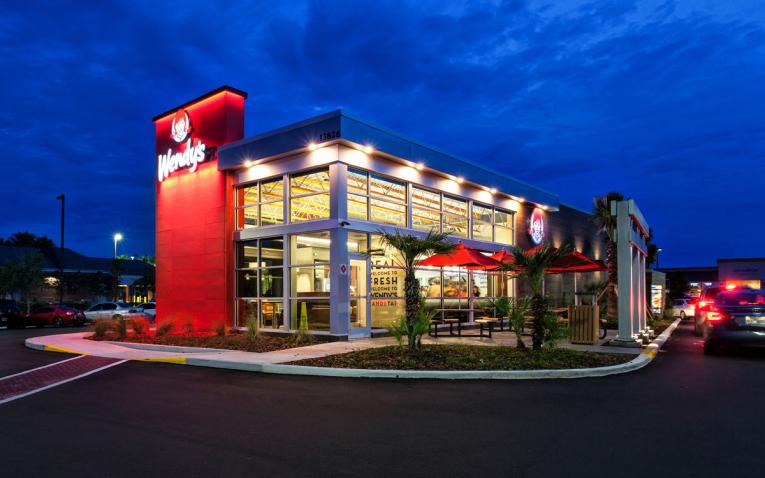Wendy’s appears to have turned a corner as global same-store sales grew in the low single digits during the final week of May.
Comp sales sequentially improved each week in May after a disruption in beef supply. Wendy’s finished the month down 3.3 percent, with a 1.9 percent decline domestically and a 15.7 percent drop internationally. That’s a significant lift from April when global comps slipped 15.3 percent, with U.S. units sliding 14 percent and international stores plummeting 28.3 percent. Quarter to date through May 31, global same-store sales fell 9.9 percent, which breaks out to an 8.6 percent decrease at domestic locations and a 22.4 percent downturn at international stores.
Wendy’s much-anticipated breakfast menu, which debuted in March right before the pandemic, captured 8 percent of domestic sales in May. It’s a solid figure considering the daypart’s overall softness during COVID-19, as morning routines take a hit due to remote work and routine disruption.
In Q1, CEO Todd Penegor said Wendy’s initial breakfast launch pushed U.S. comps to plus 16 percent, year-over-year, in the first week of March.
It mixed at the same 8 percent or so of U.S. sales in April as well. And this without the help of a heavy marketing plan Wendy’s scaled back in coronavirus cutbacks.
Headed into the fiscal year, Wendy’s planned to drop between $70 million and $80 million on advertising alone to raise breakfast awareness in 2020. Corporate expected to front $40 million to $50 million of that cost (franchisees would pay the rest).
Additionally, Wendy’s designed the drive-thru focused service to run with three added employees, or a hiring push of 20,000 people the company put $20 million upfront to fund.
In that launch week, Penegor said, Wendy’s reached customer awareness levels north of 50 percent. Typically, an LTO at Wendy’s that runs for three to four weeks generates about half of that.
Due to the pandemic, Wendy’s abated national marketing fund contributions on breakfast sales for the remainder of the year and took the staffing requirement down to two employees. In response, current breakfast breakeven dropped by about 35 percent on average, Penegor said, which helped keep it profitable despite lowered sales volume. He said in May breakfast business was “throttled in absolute dollars with mobility down and not having the morning routine.” However, given the mix and profitability despite that, Penegor noted, Wendy’s was looking forward to seeing that start to come back as restrictions and lockdowns lift. And that’s where the company is headed now.
As of May 31, 99 percent of Wendy’s 5,861 U.S. units were open while 81 percent of the 945 international units running. The majority of open stores are operating via drive-thru and delivery, with dining rooms opening at each operator’s discretion, the company said Monday. Restaurants that are closed in the U.S. are mostly in nontraditional locations like malls. Stores closed internationally are still facing country-wide closure mandates.
The brand said it “expects to continue its Wendy’s system restaurant and dining room reopening process through a phased approach in accordance with federal, state and local guidance, with customer and team member safety as its top priority.”
Continuing another COVID-19 change, digital mixed 4.5 percent in Wendy’s sales update, a figure temporarily impacted by the beef supply disruption since some items were removed from mobile and delivery menus if an individual store had supply issues.
Pre-crisis, Wendy’s digital accounted for 2.5 percent of its business in 2019.
It’s pushed the figure higher due to increased demand (quarantine behavior) and the addition of new delivery partners. Wendy’s said in Q1 Postmates was recently brought on, with Uber Eats on deck. Grubhub was added in February to join DoorDash. Mobile ordering covered the rest of recent growth.
Wendy’s said in May app downloads and active users were up 25 percent since March. And it was preparing to launch a loyalty program in the near future.
The company added Monday its beef supply has returned to “near-normal levels” after combatting shortages through the first part of May. The brand managed the disruption by allocating beef to all restaurants, with deliveries happening two or three times a week—consistent with the normal schedule. The chain also focused its marketing on chicken-based items to lighten the demand for beef.
It was never entirely clear how much disruption Wendy’s faced. Ahead of its Q1 earnings, Stifel analysts said they analyzed a random sampling of Wendy’s menus and found 5–10 percent presented chicken-only lineups.
CNN Business put the number at 1,000, or 18 percent, of Wendy’s 5,500 domestic restaurants that were not serving any hamburgers or other meat-based items—a figure came from financial firm Stephens, which said online menus shifted to emphasize chicken sandwiches. Company analyst James Rutherford suggested, in states such as Ohio, Michigan, and New York, about 30 percent of Wendy’s were out of fresh meat.
Penegor addressed this in May by saying some Wendy’s restaurants still had beef—they just weren’t showcasing it on the menu in order to guard short supply. Locations had the ability to turn beef products off in mobile and online menus. Penegor called it “an abundance of caution” intended to make sure the customer wasn’t disappointed.
Wendy’s said the issue was temporary, with “probably a couple of weeks” of tightness ahead. That appears to have been the case.
BTIG analyst Peter Saleh estimated Tuesday in a note the fresh beef shortage likely provided a mid-single digit headwind to comps for May. He noted that some operators were allowed to resort to frozen beef if needed.
The company, which does not intend to provide any further COVID-19 sales updates outside of its typical quarterly reports, has roughly $375 million in cash on hand.

